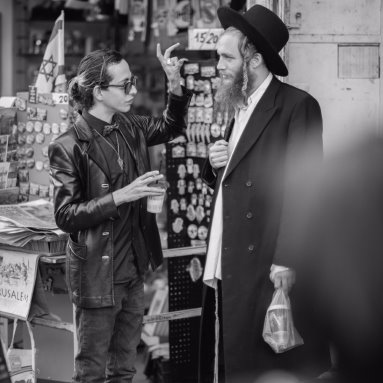News
Creating dialogue through Instagram
It is a paradox of travel that as we adventure into exotic distant lands, what we really want is to feel at home.

SIMON SHEER
For South African Instagram star Alexi Portokallis, an invitation from a stranger became the defining moment of his first visit to Jerusalem. “We went to a Shabbos dinner. A guy we’d never met invited us to his home and gave us kneidlach and told us funny jokes.”
“It’s a joyous culture; people want to share,” added fellow Instagram sensation Miklas Manneke, who was doubly surprised when a second stranger invited the duo to dinner on their way to their scheduled rendezvous.
Portokallis and Manneke were in Israel as part of an Instagram exchange programme organised by the Israeli Embassy and the South African Friends of Israel. Two prominent Israeli Instagrammers – Ella Uzan and Sasha Rozenson – were given a chance to come to South Africa.
The idea is to create photo dialogues that explore the diversity in the two countries and the similarities between South Africa and Israel, Israel’s Deputy Ambassador to South Africa Ayellet Black, explained. With around 250 000 followers between the Instagram stars, the exchange is a high-impact way to share their discoveries.
Selecting locations conducive to meaningful visual storytelling, presented a unique set of challenges, as Benji Shulman – who shepherded the photographers through Israel – soon discovered. Shulman explained that many of the usual tourist spots are interesting, but not necessarily visually exciting. His challenge was to find places that presented strong narrative interest that were also visually compelling.
The itineraries were carefully curated to enable the photographers to make connections and experience the diverse people, religion, culture, food and landscape of each country. They also wanted them to observe the differences between them, but also to discover similarities.
Sometimes similarities only become apparent when you step back and compare perspectives, which is one reason an open-ended dialogue can be so interesting. To the South Africans on their first visit to the Holy Land, a spontaneous Shabbos invitation from a stranger was a revelation.
But Uzan said that in South Africa there were clear echoes of home, a warmth and a friendliness in the people that you don’t see everywhere. “It was different from Europe; everyone is smiling and happy.”
Both countries are famously diverse, but the scale of the Israeli landscape, just how much culture and contrast were packed into a tiny geographic area, impressed the South Africans.
“Travelling from Jerusalem to Tel Aviv to Haifa was a wild journey,” Portokallis told me, a rush of colours and opinions, “a melting pot of ideas”. Gazing at the ocean in Haifa, he couldn’t quite believe that he’d only just been in Jerusalem, standing “on the holiest soil in the world”, and now he felt like he was in California.
Even a single city could feel like a world. Manneke was amazed at how the streets of downtown Tel Aviv were packed even on a weeknight. The energy felt like Los Angeles. Then you would walk to Jaffa and experience something completely different, a meeting of cultures in a neighbourhood that looks a bit like Italy in the Middle East.
Though struck by Israel’s diversity, the South Africans were also fascinated by the unique feeling of Jewishness.
For Manneke, seeing people go about their business on a Sunday as if it were a Monday in South Africa, reminded him of how profoundly Christian culture has influenced South Africa and the West generally.
Portokallis, who has dated a Jewish woman and was already a veteran of numerous Shabbos dinners, says that his visit deepened his appreciation for Judaism and his understanding of its culture and traditions.
Speaking from South Africa, Rozenson was similarly startled by Johannesburg’s strange juxtapositions, encountering places that “looked like heaven” a few kilometres from areas in desperate need of renewal.
Rozenson and Uzan’s most meaningful human connections in South Africa were made at a school in Inanda, Soweto. When they arrived at the school, the kids noticed Rozenson’s camera and started running toward the visitors, to ask to be photographed or simply to play with Uzan and Uzan.
The visit to the school, the site of a Jewish project to assist the schoolchildren, overwhelmed Uzan, who said her eyes teared up to the point that she could hardly take photographs.
If Uzan and Rozenson were moved by the human beauty they encountered on their visit, they were hardly insensitive to South Africa’s natural majesty.
While the SA Jewish Report contacted Rozenson on the phone on his first morning in Cape Town, he let out a loud gasp mid-sentence. What had happened? “I just looked up and saw the mountain,” he explained.
The Instagram exchange will culminate in a joint exhibition, which will offer a chance to compare and contrast each photographer’s visual story. In the meantime, you can follow the photographers’ journeys on Instagram using the hashtag #yallayebo.